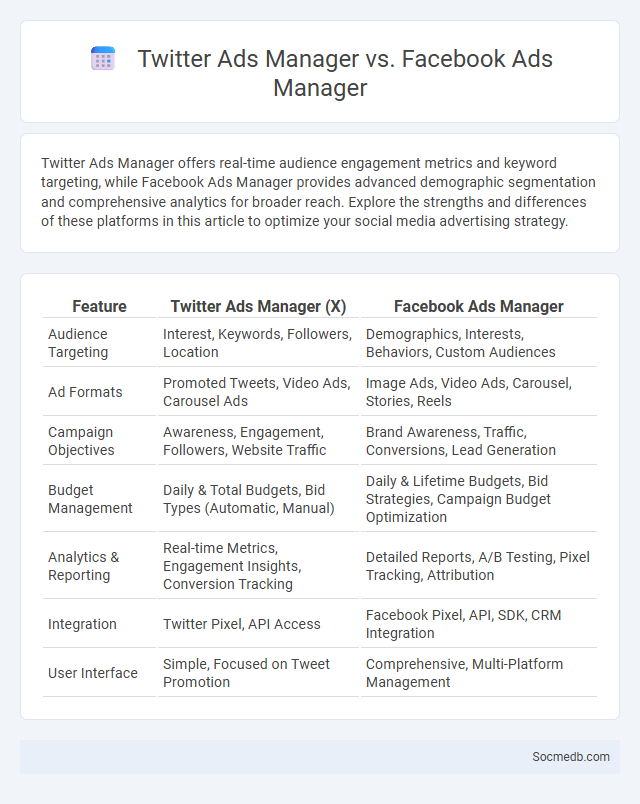
Photo illustration: Twitter Ads Manager vs Facebook Ads Manager
Twitter Ads Manager offers real-time audience engagement metrics and keyword targeting, while Facebook Ads Manager provides advanced demographic segmentation and comprehensive analytics for broader reach. Explore the strengths and differences of these platforms in this article to optimize your social media advertising strategy.
Table of Comparison
| Feature | Twitter Ads Manager (X) | Facebook Ads Manager |
|---|---|---|
| Audience Targeting | Interest, Keywords, Followers, Location | Demographics, Interests, Behaviors, Custom Audiences |
| Ad Formats | Promoted Tweets, Video Ads, Carousel Ads | Image Ads, Video Ads, Carousel, Stories, Reels |
| Campaign Objectives | Awareness, Engagement, Followers, Website Traffic | Brand Awareness, Traffic, Conversions, Lead Generation |
| Budget Management | Daily & Total Budgets, Bid Types (Automatic, Manual) | Daily & Lifetime Budgets, Bid Strategies, Campaign Budget Optimization |
| Analytics & Reporting | Real-time Metrics, Engagement Insights, Conversion Tracking | Detailed Reports, A/B Testing, Pixel Tracking, Attribution |
| Integration | Twitter Pixel, API Access | Facebook Pixel, API, SDK, CRM Integration |
| User Interface | Simple, Focused on Tweet Promotion | Comprehensive, Multi-Platform Management |
Introduction to Digital Ad Campaign Management
Digital ad campaign management involves strategizing, creating, and optimizing ads across social media platforms to reach targeted audiences effectively. Mastering tools like audience segmentation, budget allocation, and performance analytics ensures your ads generate maximum engagement and return on investment. You can leverage platforms like Facebook Ads Manager and Google Ads to scale your campaigns efficiently and achieve precise ad targeting.
Overview of Twitter Ads Manager
Twitter Ads Manager offers a comprehensive platform for creating, managing, and optimizing advertising campaigns targeted to specific audiences based on demographics, interests, and behaviors. The tool provides real-time analytics and performance metrics, enabling you to refine your strategy for maximum engagement and ROI. With features like promoted tweets, follower campaigns, and trend targeting, Twitter Ads Manager helps your brand increase visibility and drive meaningful interactions.
Overview of Facebook Ads Manager
Facebook Ads Manager is a comprehensive platform designed to create, manage, and analyze advertising campaigns across Facebook's extensive network. It offers advanced targeting options, detailed performance metrics, and budget control to optimize your ad spend efficiently. Utilizing Ads Manager can significantly enhance your ability to reach specific audiences and achieve your marketing goals with precision.
Core Features Comparison
Social media platforms differ significantly in their core features, with Facebook emphasizing extensive networking and content sharing, Instagram prioritizing visual storytelling through photos and videos, and Twitter focusing on real-time microblogging with concise updates. LinkedIn specializes in professional networking and industry-specific content, while TikTok offers short-form video creation paired with sophisticated algorithm-driven content discovery. These distinctions shape user engagement strategies and content distribution across diverse social media ecosystems.
Audience Targeting Capabilities
Social media platforms offer advanced audience targeting capabilities that enable precise segmentation based on demographics, interests, behaviors, and location. Utilizing algorithms and data analytics, these platforms allow you to deliver personalized content and ads to users most likely to engage with your brand. Leveraging these targeting features maximizes your campaign's effectiveness and return on investment.
Ad Formats and Creative Options
Social media platforms offer diverse ad formats including image ads, video ads, carousel ads, and story ads, enabling you to tailor your campaigns to various audience preferences and engagement styles. Creative options such as interactive polls, augmented reality filters, and shoppable posts enhance user interaction, boosting conversion rates and brand awareness. Leveraging these ad formats and creative tools strategically optimizes your reach and drives measurable results across social channels.
Budgeting and Bidding Systems
Effective budgeting and bidding systems on social media platforms maximize your advertising ROI by enabling precise control over spend and targeting. Automated bidding strategies use real-time data and machine learning to optimize bids for your specific campaign goals, whether it's increased clicks, conversions, or impressions. Allocating budget wisely across campaigns ensures that your ads reach the right audience segments while minimizing wasted ad spend.
Analytics and Reporting Tools
Social media analytics and reporting tools provide detailed insights into user behavior, engagement metrics, and campaign performance, enabling businesses to optimize their strategies effectively. Platforms like Hootsuite, Sprout Social, and Google Analytics offer real-time data visualization and sentiment analysis, allowing marketers to track audience growth, conversion rates, and content reach. Leveraging these tools enhances decision-making, improves ROI, and supports targeted content creation based on actionable data trends.
Integration with Third-Party Platforms
Integration with third-party platforms enhances social media functionality by enabling seamless data exchange and user interaction across diverse applications such as CRM systems, marketing tools, and analytics software. This connectivity boosts user engagement, streamlines content sharing, and improves targeted advertising through API-driven synchronizations and automation workflows. Social media platforms leveraging integrations with e-commerce, news aggregators, and communication apps increase their ecosystem value and user retention.
Choosing the Right Platform for Your Ad Campaign
Selecting the ideal social media platform for your ad campaign depends on your target audience's demographics, interests, and behaviors, ensuring your message reaches the right users. Platforms like Facebook offer extensive targeting options, while Instagram excels with visual content for younger demographics, and LinkedIn is effective for B2B marketing. Understanding each platform's strengths and aligning them with your campaign goals maximizes engagement and return on investment.
 socmedb.com
socmedb.com